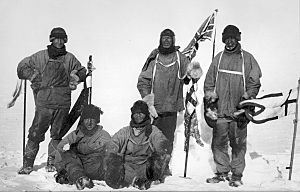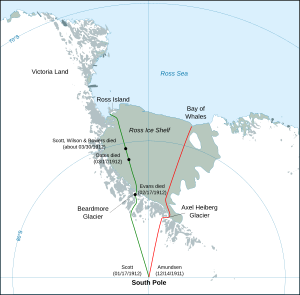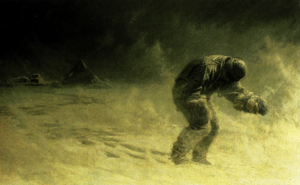Lawrence Oates facts for kids
Quick facts for kids
Lawrence Oates
|
|
|---|---|
 |
|
| Born |
Lawrence Edward Grace Oates
17 March 1880 |
| Died | 17 March 1912 (aged 32) Ross Ice Shelf, Antarctica
|
| Cause of death | Hypothermia |
| Other names | Titus Oates |
| Education | Eton College |
| Occupation | Cavalry officer, explorer |
Lawrence Edward Grace Oates (born March 17, 1880 – died March 17, 1912) was a brave British army officer and explorer. He is famous for his act of self-sacrifice during the Terra Nova Expedition to Antarctica. He died from extreme cold (hypothermia) on his 32nd birthday. Oates chose to walk out into a blizzard, knowing it would lead to his death. He did this to give his three companions a better chance to survive, as his own severe frostbite and gangrene were slowing them down.
Contents
Who Was Lawrence Oates?
Lawrence Oates was born in Putney, England, in 1880. His family was wealthy and owned land. His uncle, Frank Oates, was also a famous naturalist and explorer.
Oates went to Eton College, a well-known school, but left early due to poor health. He then prepared for the army at another school. His father passed away in 1896.
Oates's Army Life
In 1898, Oates joined the British army. He fought in the Second Boer War in South Africa. During a battle in 1901, he was shot in the leg. Even though he was badly hurt, he refused to give up. He was even suggested for the Victoria Cross, a very high award for bravery.
He became a lieutenant in 1902 and a captain in 1906. He served in different countries like Ireland, Egypt, and India. People often called him "Titus Oates" as a nickname.
The Terra Nova Expedition
Joining the Expedition
In 1910, Oates wanted to join Robert Falcon Scott's journey to the South Pole. This journey was called the Terra Nova Expedition. Scott accepted him mainly because Oates knew a lot about horses. Oates also paid £1,000 to help fund the trip.
His main job was to care for the 19 ponies. These ponies were meant to pull sledges with supplies. Scott later chose Oates to be one of the five men who would make the final push to the South Pole.
Challenges and Disagreements
At first, Oates was not very popular with the other crew members. He also often disagreed with Scott about how to manage the expedition. Oates thought the ponies Scott bought were too old and weak. He wrote in his diary that Scott's knowledge about traveling with animals was "colossal" (meaning huge) but in a negative way.
He also wrote that he "disliked Scott intensely." However, he also admitted that these harsh words came from the very difficult conditions they faced. Scott, on the other hand, called Oates "the cheery old pessimist." He understood that Oates often saw the bad side of things, but that was just his personality.
Race to the South Pole

Scott, Oates, and 14 other team members started their journey to the South Pole on November 1, 1911. Along the way, some support teams turned back. By January 4, 1912, only five men remained: Scott, Edward Wilson, Henry Bowers, Edgar Evans, and Oates. They had about 167 miles left to go.
On January 18, 1912, they finally reached the South Pole. But they found a tent left by Norwegian explorer Roald Amundsen. Amundsen and his team had reached the Pole on December 14, 1911, beating Scott's group by 35 days.
The Difficult Return Journey
The journey back was incredibly hard. The weather was terrible, food was scarce, and the men suffered from falls, scurvy (a disease from lack of vitamin C), and frostbite. On February 17, 1912, near the Beardmore Glacier, Edgar Evans died. He might have been hurt from a fall a few days earlier.
By March 15, Oates was very ill. His frostbite and gangrene were severe. He told his friends he could not go on and asked them to leave him behind. They refused. He managed to walk a few more miles that day, but his condition worsened that night.
Oates's Sacrifice
According to Scott's diary, on March 16 or 17, Oates made a brave decision. He walked out of their tent into a freezing blizzard. Scott wrote: "We knew that poor Oates was walking to his death, but though we tried to dissuade him, we knew it was the act of a brave man and an English gentleman."
Scott's diary also says that as Oates left the tent, he said, "I am just going outside and may be some time." This act was meant to save his friends. By removing himself, he hoped they would have a better chance to reach safety without having to care for him.
Scott, Wilson, and Bowers continued for another 20 miles. But a fierce blizzard stopped them on March 20. They were trapped in their tent, too weak and cold to move. They died nine days later, just 11 miles from a food supply depot that could have saved them.
A search party found Scott, Wilson, and Bowers on November 12. Oates's body was never found. Near where he was thought to have died, the search party built a stone pile (cairn) and a cross. It read: "Hereabouts died a very gallant gentleman, Captain L. E. G. Oates, of the Inniskilling Dragoons. In March 1912, returning from the Pole, he walked willingly to his death in a blizzard, to try and save his comrades, beset by hardships."
Lawrence Oates's Legacy
Oates's act of self-sacrifice is remembered as one of the most heroic examples in history. His simple final words are often seen as a perfect example of the British "stiff upper lip" attitude, meaning staying calm and brave in tough times.
Oates's reindeer-skin sleeping bag is now on display at the Scott Polar Research Institute museum in Cambridge. Other items from the expedition are also there.
The Oates Museum at Gilbert White's House in Selborne, Hampshire, tells the stories of Lawrence Oates and his uncle Frank.
The Royal Dragoon Guards, a military regiment, have a special day to remember Oates. His medals are kept at their museum in York.
In 1913, his fellow officers placed a brass memorial plaque for him in a church in Gestingthorpe, Essex. His mother polished it every week for the rest of her life.
A famous painting called A Very Gallant Gentleman by John Charles Dollman shows Oates walking out into the blizzard. It hangs in the Cavalry Club in London.
In May 1914, a memorial to Oates was placed at Eton College. It was made by Kathleen Scott, the wife of Robert Falcon Scott.
A school in Meanwood, Leeds, was named after him (it closed in 1992). On the 100th anniversary of his death, a blue plaque was put up in his honor at Meanwood Park. Another blue plaque was unveiled in 2007 at the site of his childhood home in Putney, London.
See also
 In Spanish: Lawrence Oates para niños
In Spanish: Lawrence Oates para niños
- Oates Coast






